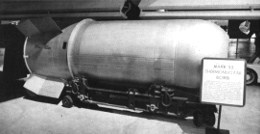On 13 October 2010, the US National Nuclear Security Administration (NNSA) announced that it had authorized its Pantex Plant in Amarillo, Texas, to begin dismantling the B-53 weapons system.
The B-53 - a freefall strategic thermonuclear bomb - is the longest-serving weapon in the history of the US nuclear arsenal, and according to the NNSA, is one of the longest-lived weapons ever fielded. The B-53 was based on the Mk-53 warhead design, which was also used as the explosive component of the W-53 warhead carried by the Titan II ICBM. With a nominal yield of 9 Mt, it was one of the most powerful weapons ever put into operational service by the US (the most powerful being the 25 Mt Mk-41). Its primary role, both in the bomb and ICBM warhead variants, was the destruction of hardened and deeply-buried targets, generally command and control centres.
Equipped with five parachutes, the bomb – which, at 12’6” long, more than 4’ in diameter, and weighing in at nearly 9000 pounds, was roughly the size and weight of a grossly overloaded minivan (Note 1) – could be delivered from high altitude, either in freefall or retarded mode; or in a low-altitude laydown attack, using its three enormous main parachutes. The laydown option was facilitated by a shock-absorbing nosecone constructed of about 150 pounds of aluminum in a honeycomb pattern. Multiple fuzing options allowed detonation at variable altitudes, on contact with the ground, or even delayed detonation (e.g., following a laydown strike, to enable the delivering aircraft to escape prior to detonation). During its operational life, the weapon was carried by the B-47 and B-52 strategic bombers (especially in the internal bomb bay of the B-52G), and also, in a modified pod, by the B-58 “Hustler” (Note 2).
The bomb was produced in both Y1 (“Clean”) and Y2 (“Dirty”) versions. The difference between the two is that the “clean” version was a two-stage weapon, with an Oralloy (enriched uranium, no plutonium) fission primary used to drive a Lithium-6 deuteride fusion secondary. This weapon would have had an outer jacket constructed of lead or titanium. The “dirty” version, by contrast, would have had an outer jacket constructed of U-238 (depleted uranium), which, although normally non-fissile, would be driven to a fission reaction by the pressure and neutron flux generated by the fusion secondary, making this version a “three-stage” weapon. While there is only one reported yield for the weapon (the aforementioned 9 Mt), the addition of the U-238 casing in the Y2 variant would have resulted in a significantly higher yield than the Y1. Although it had a mechanical firing safety, the bomb originally lacked modern Permissive Action Link safety features. These were incorporated during life-extension upgrades in the late 1980s.
The B-53
Development of the weapon was initiated in November 1955 by a DOD request for a new “C”-class weapon (megaton-range, 40” diameter). The Mk-53 warhead was designed at Los Alamos, as an evolution of the very first solid-fuelled radiation implosion (“Teller-Ulam”) device ever tested, the infamous “Shrimp” that over-performed so startlingly in the Castle Bravo test of 1 March 1954, when the explosion produced 15 Mt instead of the expected 6 Mt, more or less obliterating Eniwetok Atoll, and creating the worst radiological disaster in US history when the Marshall Islands were blanketed with fallout. The warhead was tested during the 1958 “Hardtack” series of shots in the Pacific testing range. Among the 35 test shots of the series, the “Oak” shot on 28 June 1958 (after the failed “Yellowwood” test, where the secondary fizzled) generated 8.9 Mt. Only the “Poplar” shot two weeks later, which tested the full Mk-41 design, was larger - and “Poplar” was the 5th largest yield of all US nuclear tests.
The Hardtack Oak shot, Bikini Atoll, 28 June 1958
W-53 Titan ICBM variant
The W-53 - the ICBM warhead variant - was unique to the Titan II, and was retired and dismantled when the Titan IIs were retired. The Titan II fleet was operational from 1963 to 1987.
The Reagan Administration had planned to retire the B-53 in favour of the more modern B-83 (which Christian Slater, in the otherwise abysmal movie Broken Arrow, refers to as a “crowd-pleaser”). These plans were shelved in the mid-1980s, possibly due to the significantly lower yield of the B-83 (nominally 1.2 Mt). In 1987, only 25 B-53s remained in service, so the DOD decided to refurbish and return to service another 25 in order to continue to be able to hold at risk hardened and deeply buried targets. This is the only time that such a thing ever happened in the US strategic stockpile.
B-41
If Dr. Strangelove - perish the thought! - were ever to be remade, the B-83, while the most powerful weapon remaining in the US strategic arsenal, would – at only 18” in diameter and a quarter the weight of the B-53 – make a far less impressive ride for whomever was lucky enough to land the role of Major “King” Kong.
Cheers,
//Don//
Notes
1) The actual physics package of the bomb, based on the test devices used in the Hardtack Phase 1 test series, was rather smaller – only about 102 inches long and 3 feel in diameter, and weighing about 3 tons. Most of the rest of the bomb’s structure was made up of the shock-absorbing nosecone, the tailfin and parachute assembly, the fusing assembly, and an aerodynamic casing.
2) B-53/W-53 delivery systems included the B-47 Stratojet, B-52G Stratofortress, B-58 Hustler (the bomb was carried in a special BLU-2 pod on the centreline hardpoint), and the Titan II ICBM.




